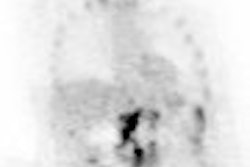Sentinel nodes can be readily identified during head and neck surgery by using a radionuclide-labeled colloid, according to presenters at the 2003 American Academy of Otolaryngology-Head and Neck Surgery Foundation meeting in Orlando, FL. In addition, careful dissection of the nodes appears to correlate with full neck dissection.
"Accurate localization of the sentinel nodes was possible in all cases by using lymphoscintigraphy and by use of a gamma probe," said Dr. Peter Zbaren from the department of otorhinolaryngology, head and neck surgery at the University of Bern Inselspital in Bern, Switzerland.
In the study, Zbaren and his colleagues set out to assess the accuracy of sentinel lymph node identification in patients with stage NO (no evidence of regional lymph node metastasis)
in squamous cell carcinoma of the oral cavity and oropharynx. Using a radionuclide-labeled colloid, preoperative lymphoscintigraphy, and intraoperative sentinel lymph node identification by gamma probe, they found 82 sentinel nodes in 36 patients -- about 2.2 nodes per patients.
Surgeons excised the sentinel lymph node in vivo, and then a frozen-section analysis was performed. A supraomohyoid neck dissection was then performed in all cases. The neck dissection specimens were analyzed according to a prospective protocol, Zbaren said.
The pathology analysis located one occult cancer in a sentinel lymph node. To correlate their findings, the surgeons carried out a complete neck dissection in the patients, removing an average of 36 nodes from each patient. In the 1,295 nodes analyzed, just one positive node was found.
Zbaren said the sensitivity of sentinel lymph node biopsy in the series was 93%, and the negative predictive vale was 94%. Complete dissection resulted in 100% sensitivity and 100% negative predictive value.
The researchers concluded that the results suggested that using this sentinel node procedure could reduce the need for more extensive biopsy procedures.
Commenting on the study was Dr. LaMar McGinnis, clinical professor of surgery at Emory University in Atlanta. "Because head and neck cancers tend to be epidural in nature, these malignancies are likely to be great candidates for finding a sentinel node," he said.
McGinnis, who also is a senior medical consultant to the American Cancer Society, added that "sentinel node biopsy is already standard-of-care in melanoma patients and is close to becoming standard-of-care in breast cancer. In head and neck cancer, use of the procedure is likely to make treatment of this disease less disfiguring than complete neck dissection."
By Edward SusmanAuntMinnie.com contributing writer
October 20, 2003
Related Reading
Sentinel-node biopsy effective in screening for breast cancer metastasis, August 7, 2003
Sentinel node with highest isotope count may not contain melanoma metastases, February 4, 2003
Sentinel lymph node mapping safe and reliable for melanoma of head and neck, January 21, 2003
Copyright © 2003 AuntMinnie.com



















